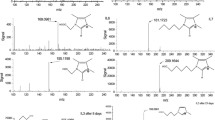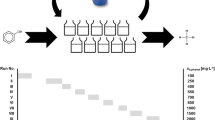Abstract
Ionic liquids (ILs) are novel organic salts that have enormous potential for industrial use as green replacements for harmful volatile organic solvents. Varying the cationic components can alter the chemical and physical properties of ILs, including solubility, to suit a variety of industrial processes. However, to complement designer engineering, it is crucial to proactively characterize the biological impacts of new chemicals, in order to fully define them as environmentally friendly. Before introduction of ILs into the environment, we performed an analysis of the biodegradability of six ILs by activated sludge microorganisms collected from the South Bend, Indiana wastewater treatment plant. We examined biodegradability of 1-butyl, 1-hexyl and 1-octyl derivatives of 3-methyl-imidazolium and 3-methyl-pyridinium bromide compounds using the standard Organisation for Economic Cooperation and Development dissolved organic carbon Die-Away Test, changes in total dissolved nitrogen concentrations, and 1H-nuclear magnetic resonance analysis of initial and final chemical structures. Further, we examined microbial community profiles throughout the incubation period using denaturing gradient gel electrophoresis (DNA-PCR-DGGE). Our results suggest that hexyl and octyl substituted pyridinium-based ILs can be fully mineralized, but that imidazolium-based ILs are only partially mineralized. Butyl substituted ILs with either cation, were not biodegradable. Biodegradation rates also increase with longer alkyl chain length, which may be related to enhanced selection of a microbial community. Finally, DGGE analysis suggests that certain microorganisms are enriched by ILs used as a carbon source. Based on these results, we suggest that further IL design and synthesis include pyridinium cations and longer alkyl substitutions for rapid biodegradability.







Similar content being viewed by others
References
Allen DT, Shonnard DR (2002) Green engineering. Prentice-Hall, Upper Saddle River
Bernot RJ, Brueseke MA, Evans-White MA, Lamberti GA (2005a) Acute and chronic toxicity of imidazolium-based ionic liquids on Daphnia magna. Environ Toxicol Chem 24(1):87–92
Bernot RJ, Kennedy EE, Lamberti GA (2005b) Effects of ionic liquids on the survival, movement, and feeding behavior of the freshwater snail, Physa acuta. Environ Toxicol Chem 24(7):1759–1765
Biorad Life Science Group (1996) The Dcode Universal Mutation Detection System. Biorad Life Science Group, Hercules
Boethling RS (1996) Designing biodegradable chemicals. Designing safer chemicals: ACS symposium series 640:156–171
Bonhôte P, Dias AP, Papgeorgiou N, Kalyanasundaram K, Gratzel M (1996) Hydrophobic, highly conductive ambient-temperature molten salts. Inorg Chem 35(5):1168–1178
Brennecke JF, Maginn EJ (2001) Ionic liquids: innovative fluids for chemical processing. AIChE J 47:2384–2389
Cammarata L, Kazarian SG, Salter PA, Welton T (2001) Molecular states of water in room temperature ionic liquids. Phys Chem Chem Phys 3(23):5192–5200
Docherty KM, Kulpa CF (2005) Toxicity and antimicrobial activity of imidazolium and pyridinium ionic liquids. Green Chem 7:185–189
Docherty KM, Hebbeler SZ, Kulpa CF (2006) An assessment of ionic liquid mutagenicity using the Ames Test. Green Chem 8(6):560–567
Dupont J, deSouza RF, Suarez PAZ (2002) Ionic liquid (molten salt) phase organometallic catalysis. Chem Rev 102:3667–3692
Fredlake CP, Crosthwaite JM, Hert DG, Aki SNVK, Brennecke JF (2004) Thermophysical properties of imidazolium ionic liquids. J Chem Eng Data 49(4):954–964
Gathergood N, Garcia MT, Scammells PJ (2004) Biodegradable ionic liquids: part I. Concept, preliminary targets and evaluation. Green Chem 6:166–175
Gathergood N, Scammells PJ, Garcia MT (2006) Biodegradable ionic liquids: part III. The first readily biodegradable ionic liquids. Green Chem 8:56–160
Gorman-Lewis DJ, Fein JB (2004) Experimental study of the adsorption of an ionic liquid onto bacterial and mineral surfaces. Environ Sci Technol 38:2491–2495
Grabinska-Sota E, Kalka J (2004) An assessment of the toxicity of pyridinium chlorides and their biodegradation intermediates. Environ Int 28:687–690
He J, Robrock KR, Alvarez-Cohen L (2006) Microbial reductive debromination of polybrominated diphenyl ethers (PBDEs). Environ Sci Technol 40:4429–4434
Jastorff B, Störmann R, Ranke J, Mölter K, Stock F, Oberheitmann B, Hoffmann W, Hoffmann J, Nüchter M, Ondruschka B, Filser J (2003) How hazardous are ionic liquids? Structure–activity relationships and biological testing as important elements for sustainability evaluation. Green Chem 5:136–142
Kaiser JP, Feng YC, Bollag JM (1996) Microbial metabolism of pyridine, quinoline, acridine, and their derivatives under aerobic and anaerobic conditions. Microbiol Rev 60(3):483–498
Liao Q, Hussey L (1996) Densities, viscosities and conductivities of mixtures of benzene with the Lewis acidic aluminum chloride: 1-methyl-3-ethylimidazolium chloride molten salt. J Chem Eng Data 41:1126–1130
Marsh KN, Deev A, Wu ACT, Tran E, Klamt A (2002) Room temperature ionic liquids as replacements for conventional solvents—a review. Korean J Chem Eng 19(3):357–362
Muyzer G, de Waal EC, Uitterlinden AG (1993) Profiling of complex microbial populations by denaturing gradient gel electrophoresis analysis of polymerase chain reaction-amplified genes coding for 16S rRNA. Appl Environ Microbiol 59:695–700
National Toxicology Program (NTP) and National Institute of Environmental Health Sciences (NIEHS) (2004) Review of toxicological literature for ionic liquids. Prepared by Integrated Laboratory Systems Inc., Research Triangle Park
Organisation for Economic Co-operation and Development (OECD) Guideline for Testing of Chemicals 301 A-F. Adopted July 17, 1992
Pernak J, Chwala P (2003) Synthesis and anti-microbial activities of choline-like quaternary ammonium chlorides. Eur J Med Chem 38:1035–1042
Pernak J, Rogoza J, Mirska I (2001) Synthesis and antimicrobial activities of new pyridinium and benzimidazolium chlorides. Eur J Med Chem 36:313–320
Pernak J, Goc I, Mirska I (2004) Anti-microbial activities of protic ionic liquids with lactate anion. Green Chem 6:323–329
Pretti C, Chiappe C, Pieraccini D, Gregori M, Abramo F, Monni G, Intorre L (2006) Acute toxicity of ionic liquids to the zebrafish (Danio rerio). Green Chem 8:238–240
Ranke J, Molter K, Stock F, Bottin-Weber U, Poczobutt J, Hoffmann J, Ondruschka B, Filser J, Jastorff B (2004) Biological effects of imidazolium ionic liquids with varying chain lengths in acute Vibrio fischeri and WST-1 cell viability assays. Ecotoxicol Environ Saf 58(3):396–404
Scow KM (2002) Microbial ecology and in situ bioremediation of MTBE-contaminated groundwater. Bioremediation and biodegradation conference paper, Pacific Grove
Sheldon RA (2005) Green solvents for sustainable organic synthesis: state of the art. Green Chem 7:267–278
Sigma-Aldrich-Fluka (2001) Green chemistry ChemFiles: ionic liquids, fluorous phase organic synthesis (FPOS). Phase Transfer Catalysis (PTC) 1(7):1–18. (http://www.sigmaaldrich.com/img/assets/15469/chemfiles_v1n7_greenchemistry_small.pdf)
Smith AE, Hristova K, Wood I, Mackay DM, Lory E, Lorenzana D, Scow KM (2005) Comparison of biostimulation versus bioaugmentation with bacterial strain PM1 for treatment of groundwater contaminated with methyl tertiary butyl ether (MTBE). Environ Health Perspect 113(3):317–322
Stepnowski P, Storoniak P (2005) Lipophilicity and metabolic route prediction of imidazolium ionic liquids. Environ Sci Pollut Res Int 12(4):199–205
Swatloski RP, Holbrey JD, Memon SB, Caldwell GA, Caldwell KA, Rogers RD (2004) Using Caenorhabditis elegans to probe toxicity of 1-alkyl-3-methylimidazolium chloride based ionic liquids. Chem Commun 6:668–669
United States Geological Survey, National Water Quality Assessment Program (USGS NAWQA) (1995) Occurrence of the gasoline additive MTBE in shallow ground water in urban and agricultural areas. USGS Fact Sheet FS-114–95
Acknowledgements
We thank J.F. Brenneke for providing ILs and D.M. Costello for assistance in manuscript preparation. Funding provided by the National Oceanic and Atmospheric Administration, the U.S. Department of Education Graduate Assistance in Areas of National Need Fellowship to K.M. Docherty and the Indiana 21st Century Research and Technology Fund is gratefully acknowledged. This material is based upon work supported by the National Science Foundation Graduate Research Fellowship to K.M. Docherty. Any opinions, findings, and conclusions or recommendations expressed in this material are those of the author(s) and do not necessarily reflect the views of the National Science Foundation.
Author information
Authors and Affiliations
Corresponding author
Rights and permissions
About this article
Cite this article
Docherty, K.M., Dixon, J.K. & Kulpa Jr, C.F. Biodegradability of imidazolium and pyridinium ionic liquids by an activated sludge microbial community. Biodegradation 18, 481–493 (2007). https://doi.org/10.1007/s10532-006-9081-7
Received:
Accepted:
Published:
Issue Date:
DOI: https://doi.org/10.1007/s10532-006-9081-7




